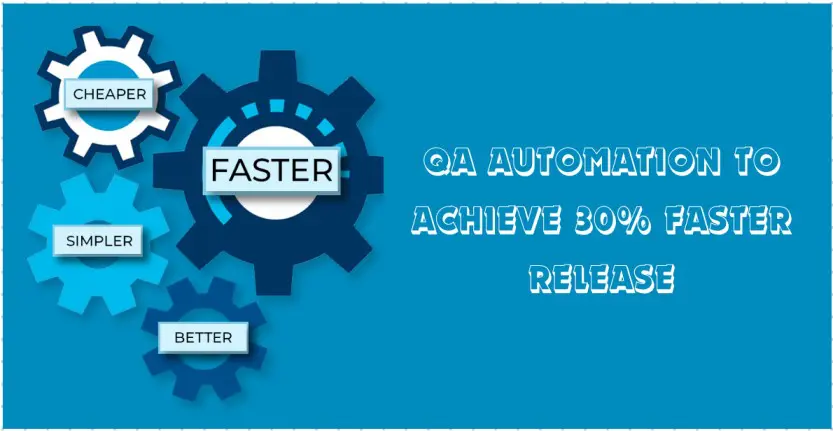How to Optimize QA Automation for 30% Quicker Releases

Introduction
In today’s fast-paced software development landscape, efficiency is key. So, if you’re wondering how to supercharge your release cycle and get products to market faster, you’re in the right place. In this blog, we’ll take you on a journey through our experience with QA automation, revealing how it played a pivotal role in boosting our release cycle by a whopping 30%. Therefore, whether you’re a seasoned developer or just starting in the world of quality assurance, join us as we unravel the secrets to streamlining your processes and achieving remarkable results.
Objective
Firstly, the primary focus of this blog is to showcase how our QA services can result in significant cost savings for companies. We achieved this by implementing an innovative approach to test automation that optimizes resources, accelerates testing processes, and minimizes manual intervention. Secondly, through this case study, we aim to illustrate the tangible benefits of investing in a strategic QA service. In the following sections, we will discuss our methodology, tools, and the benefits that the company reaped from our approach.
What is QA automation?
QA automation, short for Quality Assurance automation, refers to the process of using automated tools and technologies to perform testing and verification tasks in software development. To ensure the quality, reliability, and functionality of software applications, QA automation involves the creation and execution of scripts, test cases, and scenarios that mimic user interactions and validate various aspects of the software.
Traditional manual testing methods can be time-consuming, repetitive, and error-prone. Especially as software projects grow in complexity, QA automation aims to address these challenges by employing automated testing frameworks, tools, and scripts to execute tests more efficiently and consistently. Hence, this allows QA teams to focus on more strategic and exploratory testing tasks.
The Challenges Before QA Automation
Before diving into the nitty-gritty of our journey, let’s take a look at the hurdles we faced:
Escalating Release Cycle The time it took to release new updates was steadily increasing. Consequently, the manual testing phase was becoming a bottleneck, causing delays and frustrations.
Repetitive Testing Testing the same functionalities repeatedly was not only monotonous but also error-prone. Further, manual testing was consuming a significant portion of both testers’ and developers’ time.
Resource Drain Developers were getting entangled in the manual testing process. As a result, this diverted their focus from actual development tasks. Importantly, this hindered productivity and innovation.
Unstable Production Even after rigorous manual testing, the production environment wasn’t as stable as desired. Glitches and bugs still managed to slip through, affecting user experience.
Implementation
The Turning Point
Recognizing the need for change, we embarked on the journey to implement QA automation. Here’s what we did:
Step 1: Document Test Cases
Our first step was to establish a robust QA automation project. Our QA service follows a meticulous approach to harness the power of automation for testing. We create robust test cases using the Robot Framework, which facilitates easy customization and maintenance. By integrating Selenium, we achieve seamless browser automation that allows us to simulate user interactions and validate various functionalities of web applications.
Step 2: Automation Tool Selection and implementation
We chose Selenium and the Robot framework as our primary automation tools, enabling us to automate test cases effectively. Robot Framework is an open-source test automation framework that allows testers to write keyword-driven test cases for various types of software applications. On the other hand, Selenium is a widely used browser automation tool that enables testers to automate the testing of web applications across different browsers and platforms. The seamless integration of these two tools empowers our QA team to create robust and efficient test cases, ensuring comprehensive test coverage.
Step 3: Setting up CI/CD Pipeline for continuous change monitoring
We setup Github Actions to setup CI/CD pipeline. This pipeline triggers at two scenarios:
(1) When there is any code changes in specific branch such as “dev” branch. This ensures that whatever code are changed, it should not break any existing functionality.
(2) At a fixed daily schedule. This ensures that end-to-end system is working expectedly, even when no changes have been done.
Challenges Overcome
Navigating the Automation Journey Building our QA automation project was not without its hurdles:
Locator Challenges
One of the initial roadblocks was identifying reliable locators for test elements. So, to overcome this, we utilized various Chrome extensions like Truepath and XPath Helper, Katalon Recorder to fine-tune our locators. In other words, these extensions assist us in locating elements within web pages. As a result, our test scripts are more accurate and reliable. Importantly, they enhance the efficiency of our testing process by providing valuable insights into the structure of the web application.
Test Maintenance
As the application evolved, test scripts required constant updates. We’ve adopted Page Object Model design pattern in order to make project structure more modular which increased the re-usability, adaptability and maintainability. We also employed version control to keep our test suite manageable and maintainable.
Results Outcome

The implementation of QA automation brought about several remarkable advantages:
Improved Release Cycle
With automated testing, we significantly reduced the time required to test each release, accelerating our development-to-deployment process by 30%.
Cost Savings
By automating repetitive tasks, we saved valuable resources and reduced the cost of manual testing. The combined effect of reduced testing time and enhanced accuracy led to substantial cost savings for the client. They were able to allocate resources more efficiently, focusing on innovation rather than spending time on manual regression testing.
Scalability
As the application evolved, our automation test suite seamlessly scaled to accommodate new functionalities. In other words, this adaptability ensured that the client’s testing needs were met without compromising on quality.
Enhanced Accuracy
Automation eliminated human errors associated with repetitive testing tasks. Thus, this not only improved the accuracy of testing but also reduced the need for resource-intensive manual verification.
Reduced Testing Time
The time spent on testing was drastically reduced, freeing up our QA team to focus on more complex testing scenarios.
Early Bugs Detection
Automation helped us identify and catch bugs early in the development cycle, preventing them from reaching production.
Conclusion
In conclusion, our journey of implementing QA automation has revolutionized our software development process. We’ve not only improved our release cycle but also reduced costs, enhanced accuracy, and made testing more efficient. Importantly, despite initial challenges, the benefits far outweighed the obstacles. Our experience serves as a testament to the transformative power of QA automation in modern software development.
Further Readings
Follow Us
Disclaimer
The views are of the author and are not necessarily endorsed by Madgical Techdom.